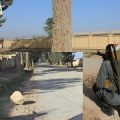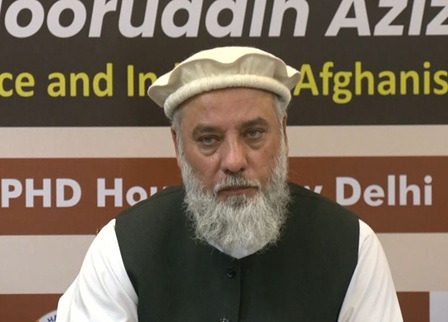
Children account for one-third of civilian casualties in Afghanistan’s grinding conflict in the first three months of 2017, and are paying an increasingly high price in the fighting, a UN report said Thursday in Kabul.
From January to March, 210 children were killed — up 17 percent from the same period last year — and 525 injured, out of a total of 2,181 civilian casualties (715 dead and 1,466 injured).
The overall total is slightly down, by four percent, compared to the same period in 2016.
Among women, 88 deaths were recorded, a figure that jumped 54 percent from last year, mainly due to aerial bombardments — an increasing danger as the Afghan Air Force begins to carry out its own strikes.
Overall, the report showed 148 deaths and injuries from airstrikes in the first quarter, compared to 29 last year.
“We are extremely concerned about the increase in the number of casualties among women and children, particularly deaths,” said the United Nations Assistance Mission in Afghanistan (UNAMA), which has documented civilian victims of the conflict since 2009.
“The 17 per cent increase in child casualties reflects the failure of parties to the conflict to take adequate precautions to protect civilians, including through marking and clearing unexploded ordnance after fighting ends,” said Danielle Bell, head of human rights for UNAMA.
The main cause of casualties remains fighting on the ground, claiming up 35 percent of the victims.
The number of civilians fleeing fighting hit a record high last year, said the UN, with 600,000 internally displaced — which, when added to hundreds of thousands of refugees returned from Pakistan in 2016, threatens to overwhelm already meagre resources allocated to refugees.
The UN blames 62 percent of civilian casualties on anti-government elements, mainly the Taliban, who are gearing up for their spring fighting season after an unusually violent winter.
Unexploded mines and ammunition abandoned by fighters remained the second highest cause of civilian casualties (19 percent of the total), with attacks marking 17 percent.
Kabul province had the highest number of casualties thanks to multiple attacks in the capital, followed by provinces where fighting is most sustained — such as Helmand, virtually under Taliban control; Kandahar and Uruzgan in the south, and Nangarhar in the east, where the Islamic State group is in a turf war with the Taliban.
“It is civilians, with increasing numbers of women and children, who far too often bear the brunt of the conflict,” said Tadamichi Yamamoto, the UN envoy to Afghanistan.
“With the so-called fighting season imminent, I appeal to all parties to take every measure possible to prevent unnecessary and unacceptable harm to Afghan civilians.”
UNAMA detailed Report:
UNAMA FIRST QUARTER 2017 CIVILIAN CASUALTY DATA
KABUL – The UN Mission in Afghanistan (UNAMA) urges all parties to the conflict to take immediate and concrete measures to better protect civilians from harm, as the latest data for 2017 released today by UNAMA shows continued high numbers of civilian casualties.
“It is civilians, with increasing numbers of women and children, who far too often bear the brunt of the conflict,” said Tadamichi Yamamoto, the Secretary-General’s Special Representative for Afghanistan. “With the so-called fighting season imminent, I appeal to all parties to take every measure possible to prevent unnecessary and unacceptable harm to Afghan civilians.”
In the first quarter of 2017, UNAMA documented 2,181 civilian casualties (715 dead and 1,466 injured), a four per cent decrease compared to the same period in 2016. Civilian deaths decreased by two per cent while civilian injuries decreased by five per cent.
Consistent with trends in 2016, ground engagements continued to cause most civilian casualties, followed by improvised explosive devices, as well as suicide and complex attacks.
The decrease in civilian casualties recorded by UNAMA is chiefly attributable to a 19 per cent reduction in civilian deaths and injuries caused by ground engagements between Pro-Government Forces and Anti-Government Elements. While UNAMA welcomes such a decrease and all efforts to protect civilians, it notes the record levels of internal displacement within Afghanistan during 2016 and that the reduction in numbers may be related to the movement of civilians from several areas severely affected by conflict. Notwithstanding this decrease, ground fighting remained the leading cause of civilian casualties – accounting for 35 per cent of all civilian casualties.
Geographically, Kabul province had the highest number of civilian casualties due to suicide and complex attacks in Kabul city, followed by Helmand, Kandahar, Nangarhar and Uruzgan provinces.
Anti-Government Elements caused 62 per cent of civilian casualties – 1,353 civilian casualties (447 dead and 906 injured), reflecting a five per cent increase compared to the same period in 2016.
Anti-Government Elements continued to target civilians intentionally and deploy indiscriminate tactics in areas with a civilian presence – in clear violation of their obligations under international humanitarian law. UNAMA documented attacks targeting civilian government employees, tribal elders, Muslim Shi’a mosques, humanitarian de-miners, NGO workers and civilians perceived to be government supporters.
“During an armed conflict, the intentional killing and injuring of civilians is a war crime” said Yamamoto. “Anti-Government Elements must stop this deplorable practice and everybody must apply – and respect – the definition of ‘civilian’ provided by international humanitarian law.”
Improvised explosive devices (all non-suicide switch types) remained the second leading cause of civilian casualties – responsible for 409 civilian casualties (126 dead and 283 injured) – a decrease of one per cent compared to the same period in 2016 and comprising 19 per cent of all civilian casualties.
Of concern, UNAMA recorded a 12 per cent increase in civilian casualties caused by pressure-plate improvised explosive devices – 218 civilian casualties (86 dead and 132 injured).
By virtue of their indiscriminate nature, pressure-plate improvised devices are illegal and pose substantial risks to civilians due to the inability of users to direct the effects of the device at a particular target once activated. UNAMA reiterates in the strongest terms its request to Anti-Government Elements to immediately end the use of this tactic.
Suicide and complex attacks continued to cause record levels of civilian harm. The Mission recorded a five percent increase in civilian casualties from these tactics – 374 civilian casualties (108 dead and 266 injured) – accounting for 17 per cent of all civilian casualties.
UNAMA attributed 21 per cent of civilian casualties to Pro-Government Forces – 451 civilian casualties (165 dead and 286 injured) – a decrease of two per cent compared to the same period in 2016.
While most civilian casualties caused by Pro-Government Forces occurred indirectly during ground fighting with Anti-Government Elements, UNAMA recorded a substantial increase in civilian casualties from aerial operations.
The mission documented 148 civilian casualties (72 dead and 76 injured) from aerial operations, a disturbing increase compared to 29 civilian casualties (eight dead and 21 injured) in the first quarter of 2016. On 3 March, an Afghan Air Force helicopter strike killed seven children and injured 24 civilians in the Bala Baluk district of Farah province during an operation targeting the Taliban.
Nine per cent of civilian casualties arose from ground fighting between Anti-Government Elements and Pro-Government Forces where the responsible party could not be determined. Unattributed unexploded ordnance caused the majority of the remaining civilian casualties.
Civilian casualties from unexploded ordnance increased by one per cent to 203 civilian casualties (50 deaths and 153 injured), of which children comprised 81 per cent.
UNAMA is extremely concerned by increases in both child and women civilian casualties, particularly deaths. The mission recorded a 24 per cent increase in women civilian casualties, documenting 273 women casualties (88 dead and 185 injured) due to increases in women killed or injured by aerial operations and suicide and complex attacks. Conflict-related deaths of women increased by 54 per cent while the number of injured women increased by 13 per cent.
Also in the first quarter, the mission recorded 735 child casualties (210 dead and 525 injured), a three per cent increase compared to the same period in 2016. Child deaths increased by 17 per cent while child injuries decreased by one per cent. Children comprised 34 per cent of all civilian casualties during the first quarter.
Increases in child casualties from aerial operations and improvised explosive devices, in conjunction with high numbers of children killed or injured by unexploded ordnance, drove the rise in child casualties.
“The 17 per cent increase in child casualties reflects the failure of parties to the conflict to take adequate precautions to protect civilians, including through marking and clearing unexploded ordnance after fighting ends,” said Danielle Bell, UNAMA’s Human Rights Director. “These numbers represent the lives of 735 girls, boys and infants – 735stories of death, maiming, physical pain, emotional trauma and grief. Parties must act now to protect children in 2017.”
Between 1 January and 31 March, the mission documented 17 conflict-related incidents targeting health-care or health-care workers, including the Daesh/Islamic State Khorasan Province-claimed attack on Kabul’s Sardar Mohammad Daud Khan Hospital that resulted in the deaths of 26 civilians and injury of 30 others in addition to numerous military medical staff and injured combatants.
UNAMA once again urges the Government of Afghanistan to prioritise the endorsement and implementation of its National Policy on Civilian Casualty Prevention and Mitigation, including the completion of an action plan for its implementation that contains measurable objectives.






